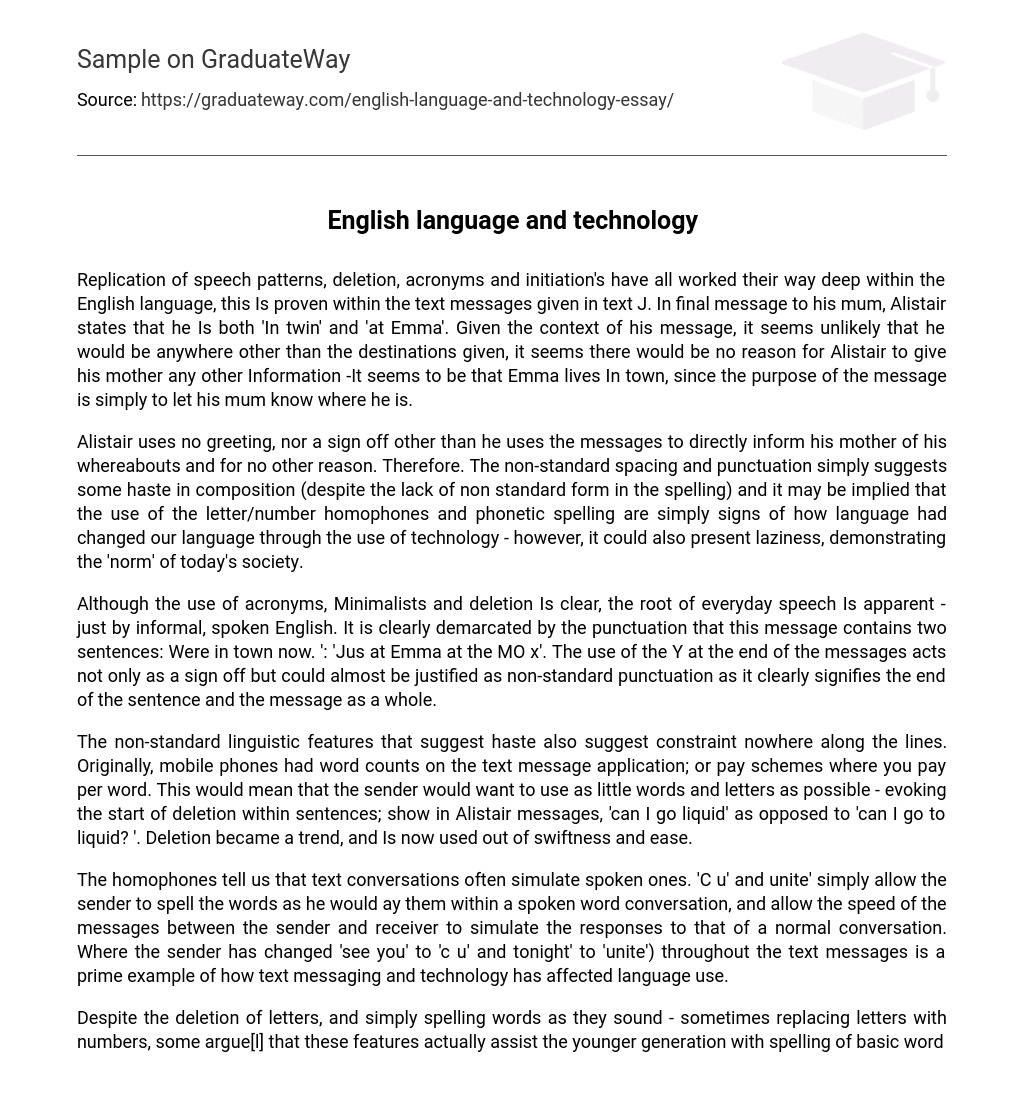Replication of speech patterns, deletion, acronyms and initiation’s have all worked their way deep within the English language, this Is proven within the text messages given in text J. In final message to his mum, Alistair states that he Is both ‘In twin’ and ‘at Emma’. Given the context of his message, it seems unlikely that he would be anywhere other than the destinations given, it seems there would be no reason for Alistair to give his mother any other Information -It seems to be that Emma lives In town, since the purpose of the message is simply to let his mum know where he is.
Alistair uses no greeting, nor a sign off other than he uses the messages to directly inform his mother of his whereabouts and for no other reason. Therefore. The non-standard spacing and punctuation simply suggests some haste in composition (despite the lack of non standard form in the spelling) and it may be implied that the use of the letter/number homophones and phonetic spelling are simply signs of how language had changed our language through the use of technology – however, it could also present laziness, demonstrating the ‘norm’ of today’s society.
Although the use of acronyms, Minimalists and deletion Is clear, the root of everyday speech Is apparent – just by informal, spoken English. It is clearly demarcated by the punctuation that this message contains two sentences: Were in town now. ‘: ‘Jus at Emma at the MO x’. The use of the Y at the end of the messages acts not only as a sign off but could almost be justified as non-standard punctuation as it clearly signifies the end of the sentence and the message as a whole.
The non-standard linguistic features that suggest haste also suggest constraint nowhere along the lines. Originally, mobile phones had word counts on the text message application; or pay schemes where you pay per word. This would mean that the sender would want to use as little words and letters as possible – evoking the start of deletion within sentences; show in Alistair messages, ‘can I go liquid’ as opposed to ‘can I go to liquid? ‘. Deletion became a trend, and Is now used out of swiftness and ease.
The homophones tell us that text conversations often simulate spoken ones. ‘C u’ and unite’ simply allow the sender to spell the words as he would ay them within a spoken word conversation, and allow the speed of the messages between the sender and receiver to simulate the responses to that of a normal conversation. Where the sender has changed ‘see you’ to ‘c u’ and tonight’ to ‘unite’) throughout the text messages is a prime example of how text messaging and technology has affected language use.
Despite the deletion of letters, and simply spelling words as they sound – sometimes replacing letters with numbers, some argue[l] that these features actually assist the younger generation with spelling of basic words. Using he term ‘unite’ instead of tonight’ suggests that to know how to phonetically spell the word, there must be some knowledge of how the word is originally supposed to be spelt. A group of students from Coventry carried out an experiment on a group of school children which gives evidence to the statement of textiles having a positive affects on the intelligence of young people that have access to such devices.
Although there being experiments and slight evidence that lies within homophones helping study and education; it also implies that the use of technology amongst society today as affected the English language and the most common technological linguistic features are working their way into the English language. Furthermore, the use of text ‘slang doesn’t harm the English language – it simply augments it. Our English language has been affected by the use of technology in the modern day, but not necessarily for the worst.
With trends such as ‘selfish’ working their way into the oxford dictionary, the English language is simply modernizing itself by forms such as augmentation. The English Language is also constrained by the use f technology because it has become ‘easy to have conversations with abbreviated words, deletion of letters, homophones and represents the sluggishness of text senders in the modern day – but also allows them to simulate a quick and easy spoken conversation.





